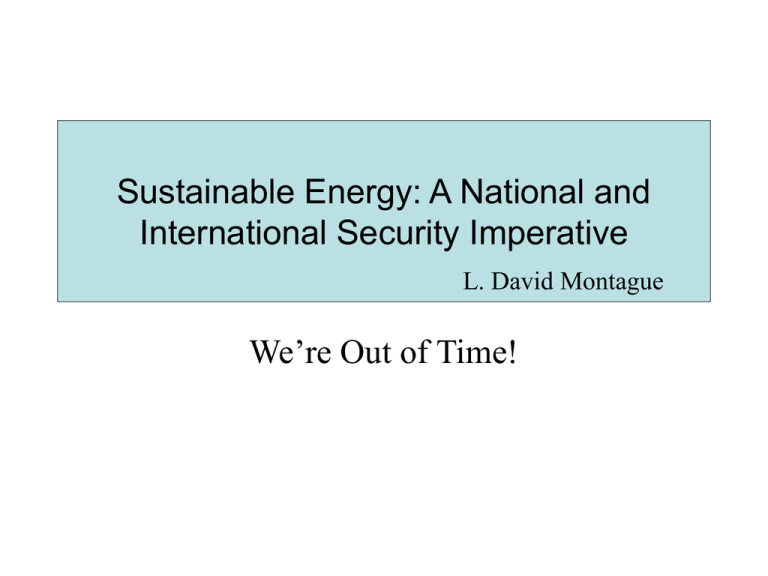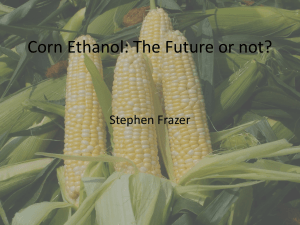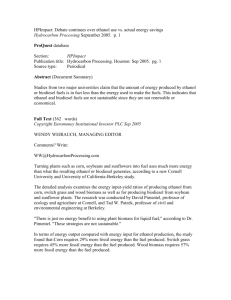
Sustainable Energy: A National and
International Security Imperative
L. David Montague
We’re Out of Time!
Sustainable Energy: A National and
International Security Imperative
L. David Montague
A paper to frame the Issues and stimulate
discussion of plausible solutions free of
energy industry influence.
–Draws and integrates data from June 2005 NAE
sponsored conference on Sustainable Energy, and
other DOE EIA sources
–Proposes a holistic near term solution against a
backdrop of national security and global warming
concerns.
Presented at the Center for International Security and Cooperation at Stanford University
February 2006
Outline of Discussion
• Current and projected US and World energy
consumption and supply by sector
• Carbon emissions and warming
• The nature of the options
–
–
–
–
–
Cleaner fossil fuels
Hydrogen, Fuel Cells
Solar, Wind,
Bio-fuels,
Nuclear
• A proposed quantifiable solution set for near and long
term mitigation of the threat
Energy use grows with economic
development
energy demand and GDP per capita (1980-2002)
400
US
Primary Energy per capita (GJ)
350
300
Australia
250
France
200
Russia
S. Korea
150
UK
Japan
Ireland
Greece
100
Malaysia
Mexico
50
China
Brazil
India
0
0
Steven Koonin
Source: UN and DOE EIA
5,000
10,000
15,000
20,000
25,000
GDP per capita (PPP, $1995)
30,000
35,000
energy demand – growth projections
Global energy demand is set to grow by over 60% over the next 30 years – 74% of
the growth is anticipated to be from non-OECD countries
Global Energy Demand Growth by Region (1971-2030)
18,000
Energy Demand (Mtoe)
16,000
14,000
12,000
10,000
8,000
6,000
4,000
2,000
0
1971
OECD
2002
2010
Transition Economies
2020
2030
Developing Countries
Notes: 1. OECD refers to North America, W. Europe, Japan, Korea, Australia and NZ
2. Transition Economies refers to FSU and Eastern European nations
3. Developing Countries is all other nations including China, India etc.
Source: IEA World Energy
Outlook 2004
growing dislocation of supply &
demand
• N. America, Europe and Asia Pacific are the three largest
demand centres
• But, have a small share of the remaining oil and gas reserves;
coal is the exception
• Their collective shares are:
• Oil - 80% of demand; 15% of conventional reserves (28%
incl. unconventional reserves)
• Gas – 61% of demand; 32% of reserves
• Coal – 89% of demand; 69% of reserves
Steven Koonin
U.S. Energy Consumption
200
180
U.S. Energy Consumption at
constant 1970 E/GDP
160
Efficiency;
Structural
Change
Quads
140
120
100
80
U.S. Energy Consumption
60
40
20
0
1950
1960
1970
1980
1990
2000
1970-2003
Gas 0.7Q
RETs 2.1
Nucl 7.7
Oil
9.6
Coal 10.4
2003 US Energy Consumption
by Sector & Source
45
40
5 Quads or
5 Trillion ft3
35
Quads
30
Electricity + Losses
Natural Gas
Petroleum
Coal
Renewables
Nuclear
25
20
15
10
5
0
Buildings
Industry
Transport Electricity
The Oil Problem
Nations that HAVE oil
(% of Global Reserves)
Nations that NEED oil
(% of Global Consumption)
Saudi Arabia
Iraq
Kuwait
Iran
UAE
Venezuela
Russia
Mexico
Libya
China
Nigeria
U.S.
U.S.
Japan
China
Germany
Russia
S. Korea
France
Italy
Mexico
Brazil
Canada
India
26%
11%
10%
9%
8%
6%
5%
3%
3%
3%
2%
2%
26%
7%
6%
4%
3%
3%
3%
3%
3%
3%
3%
3%
Source: EIA International Energy Annual
Petroleum supply, consumption, and imports, 1970-2025
(million barrels per day)
60%
71%
Scale of Challenge
Scenarios of U.S. Oil Futures
35
30
Hybrids
MMBbl/Day
25
Demand
20
15
Imports
10
Domestic Supply
5
0
1950
Biomass
ANWR
1960
1970
1980
1990
2000
2010
2020
2030
Oil & Gasoline Market Behavior
• The oil market is not a free market
– Demand is inelastic and growing while supply is elastic as long as
reserves exist
– The supply pipeline is easily manipulated
• There is no incentive for oil companies to put downward
pressure on oil prices, because profits rise directly with crude
price
– 1 bbl of crude on average yields 47% or 20 gal of gasoline;
Assuming the other 53% has no value (gross underestimate), at
$70/bbl the cost of crude per gal of gasoline would be:
(20gal gas/42gal crude) x $70/20 =$1.67 while the average price at
the pump is $3.00. Other costs are largely fixed.
– Then there is what I call the “Mysteresis” effect. Pump prices rise
instantly with crude increases but lag significantly as crude prices
go down. The pipeline is weeks long and refiners rarely contract at
the delivery day spot price.
Total=29
Total=22
Approximate Trade Deficit Contribution of
Crude Oil And Natural Gas Imports
Total
Oil $
kft3 NG
Imports
Unit
Pric
e
$400 B
3.34 B
$25
2003
$500 B
3.53 B
2004
$600 B
2005
2006
(Est.)
Year
Trade
Deficit
bbls Oil
Total
NG $
Total$
Imports
Unit
Price
2002
% of
$84 B
4.02 B
$3.15
$13B
$97B
24 %
$30
$106 B
3.94 B
$5.17
$20B
$126B
25 %
3.69 B
$39
$144 B
4.26 B
$5.81
$25B
$169B
28 %
$725 B
3.67 B
$57
$209 B
4.24 B
$6
$25B
$234B
32 %
$800 B
3.72 B
$61
$227 B
4.26 B
$6.20
$26B
$253B
32 %
Deficit
Sources: Dept of Commerce BEA and Dept of Energy EIA
Crude Oil and Natural Gas Imports Now
Make Up 32% of The Trade Deficit
CO2 emissions and GDP per capita
(1980-2002)
25
CO 2 emissions per capita (tCO2)
US
20
Australia
15
Russia
10
Ireland
UK
S. Korea
Japan
Greece
Malaysia
5
Mexico
China
India
0
0
France
Brazil
5,000
10,000
15,000
20,000
25,000
GDP per capita (PPP, $1995)
Steven Koonin
30,000
35,000
CO2 Emissions and Climate
Sam Baldwin
Climate change and CO2 emissions
-
CO2 concentration is rising due to
fossil fuel use
-
The global temperature is increasing
- other indicators of climate change
-
There is a plausible causal connection
- but the scientific case is not
overwhelming (natural
variability, forcings)
-
Impacts of higher CO2 quite uncertain
- ~ 2X pre-industrial is a widely
discussed stabilization target (550
ppm)
- Reached by 2050 under BAU
-
Precautionary action is warranted
- What could the world do?
- Will we do it?
Steven Koonin
Vectors Are in The Wrong Direction
• Growing reliance on unreliable foreign supply of energy
presents an unacceptable threat to our national security
and economic stability
– China’s projected 8%* annual growth along with other
developing countries will worsen the pressures on oil and gas
supply and prices.
– We are increasingly vulnerable to economic disruption due to
gas and oil supply interruption
– The off-shore profits help fund terrorist and fundamentalist
regimes that could cause that interruption
• The much vaunted energy bill does little to alleviate the
problem - time line is incompatible with the need
• There must and can be effective competitive energy
sources to oil and gas suppliers
* Rand Corp. Projection
Conclusions
•
•
•
Ever-increasing reliance on foreign energy supply is a real and
growing threat to national security
The US can be energy independent within 10-15 years and
radically reduce greenhouse emissions in the process
The solution seems straight forward:
– Hybrid vehicles that use bio-fuels (ethanol and bio-diesel) for the
transportation sector
– Reliance on new nuclear plants for electric power generation with fuel
reprocessing to reduce high level waste by 90%
•
We need to get on with it much more aggressively
– A major PR campaign will be required
The so called hydrogen economy is not a solution
H2 SUPPLY PATHWAYS
Like electricity, hydrogen is an energy carrier that can be
produced from widely available primary energy resources
Biomass
Solar
Wind
•
Coal w/CO2 Sequestration
Natural Gas
Nuclear
Hydrogen Production Dilemma
• 13 million barrels crude oil per day used in transportation
– equivalent to 1.46 billion pounds per day hydrogen
• This would require doubling the total US power
production (850 GWe to 1780 GWe) if hydrogen were
produced by conventional electrolysis. (assume 1 MW
per 1000 lbs)
OR
• This would require 23 trillion cubic feet of natural gas per
year - approximately 110% of the 2002 total US
consumption, nearly doubling the total natural gas
requirement.
Joan Ogden UC Davis
We are already a net importer of natural gas!!
Fuel Cell System Trends
Compared with other Distributed Generation Technologies
Electrical Generation
Efficiency %LHV
70
Combined
Cycle
60
Carbonate
Fuel Cell
Solid Oxide
Fuel Cells
50
PAFC
40
Aero
Gas
Turbines
PEM Fuel Cell
30
Industrial
Gas Turbine
20
IC
Engines
Stirling Engine
10
Microturbines
0
1
10
Residential
100
Commercial
1,000
10,000
100,000 500,000
Industrial
Size in kW
Copyright 2005 Electric Power Research Institute,Inc All rights reserved
Wholesale
Sam Baldwin
Chief Technology Officer
Office of Energy Efficiency and Renewable Energy
U.S. Department of Energy
36
Multijunction Concentrators
Three-junction (2-terminal, monolithic)
Two-junction (2-terminal, monolithic)
Crystalline Si Cells
Single crystal
Multicrystalline
Thin Si
Thin Film Technologies
Cu(In,Ga)Se2
CdTe
Amorphous Si:H (stabilized)
Emerging PV
Westing- ARCO
Dye cells
house
Organic cells
32
28
Efficiency (%)
Best Research-Cell Efficiencies
24
20
16
(various technologies)
12
Monosolar
0
1975
Kodak
Boeing
RCA
Japan
Energy
NREL
Kodak
UNSW
Spire
Georgia Tech
Varian
Georgia Tech
Sharp
ARCO
University
RCA
of Maine
RCA
RCA
RCA
RCA
1980
Boeing
AstroPower
RCA
Solarex
UNSW
NREL
Cu(In,Ga)Se2
14x concentration
NREL
Euro-CIS
Boeing
Boeing
Photon Energy
UNSW
NREL
NREL
University
So. Florida
Solarex
UNSW
UNSW
UNSW
Stanford
Spire
NREL/
Spectrolab
NREL
AstroPower
NREL
University of
Lausanne
United Solar
Princeton
1990
Siemens
University
Linz
UCSB
Kodak
NREL
NREL
University of
Lausanne
1985
NREL
United Solar
AMETEK
Masushita
4
Spectrolab
No. Carolina
State University
Boeing
8
Spectrolab
1995
Cambridge
2000
ECN,
The Netherlands
UC Berkeley
2005
026587136
Bio-fuels & Hybrids in Transportation can
eliminate our need for imported oil
• We grow things better than any nation on earth
• Biomass (corn, sugar cane and beets, sorgum, fruit,
and many other waste products) are ideal feed stock.
• Arguments over whether the life cycle net energy
balance ratio for ethanol is less than or greater than
one, are moot if biomass is converted using the sun’s
energy, or waste heat from power plants.
• CO2 is reduced by at least 30% using ethanol and
more is adsorbed in growing the biomass.
Horsepower and Gallons of Ethanol
Req'd per Hybrid Vehicle Traveling
12K miles in a year
60.0
hp and fuel
consumption
•1.2 acres of corn yield
enough ethanol (385 gal.)
to run a full sized hybrid
vehicle for 12K mi (the
average driven during a
year) at 50 mph.
•385 m2 of solar collector
operating @75% eff. In the
SW for 4.4 hrs provides
the energy needed to
convert corn feedstock to
385 gal of ethanol to run
that vehicle for a year.
50.0
40.0
30.0
20.0
10.0
0.0
40
50
60
Vehicle Speed in mph
HP Req'd vs Speed
Ethanol Fuel gal x 10-1
Ethanol Produced/Acre in gal x10-1
70
How Much Ethanol Does it Take to Run Half
of all US Cars?
• Less than 30 hp needed to maintain a car or light
truck at 68 mph against aerodynamic drag and rolling
friction; less than 9 hp to maintain it at 40 mph.
• A 35 hp Ethanol fueled IC engine augmented by
battery usage for acceleration with regenerative
braking is adequate for hybrid full size family vehicles
• to run 100 million hybrid cars for 12K miles at 50 mph
on ethanol would take 385 gal. X100 X106 or 38.5
billion gallons of ethanol/yr.
US today produces about 5 billion gal/yr of ethanol
How Much Biomass and Land to Grow and
Transform to Ethanol?
• To grow if it all came from corn:
– Corn Crop yield =122 bushels per acre, and 2.6 gal of
ethanol/bushel or 317 gal of Ethanol per acre
– 38.5 x 109 gal./317 gal./acre = 121million added acres
planted in corn compared to about 85 million acres currently
in corn for all purposes
• To transform using solar energy
– 100,000 acres or 156 sq mi. of solar collector operating 250
days per year @ 6 hrs per day at 75% efficiency transforms
enough corn to ethanol for 100 million cars for 12 k miles at
50 mph
– Includes all conversion steps: milling, cooking,
saccharification, fermenting, distilling, and dehydrating
• Can also transform using waste heat from electric
generating power plants
What Does Ethanol Cost?
Ethanol Mythology and Reality
•
Ethanol takes more energy to make it than it delivers
– Depends how you allocate energy cost to bi-products
– The argument is moot since all the energy for production can be power
plant waste heat or otherwise wasted incident solar radiation
•
Ethanol has lower energy content than gasoline so it is a poor fuel
choice - 125,300 vs 79,000 btu/gal
– Ethanol burns slower and more efficiently in an IC engine regaining almost
half of the difference in energy content.
•
Ethanol costs much more per mile than gasoline
– A gallon of Ethanol costs about 75% of gasoline in California - about the
difference in mileage per gallon
•
Engines require redesign/modification to burn ethanol
– Many engines in currently produced US cars are flexible fuel engines that
can burn any blend from pure gasoline to at least 90% ethanol
– Other fuel injection engines can be adapted at low cost.
•
Ethanol production and distribution cannot be increased rapidly
– Existing gasoline distribution can be readily used for ethanol and production
facilities can and will grow to meet demand
2nd Generation Hybrid Vehicle Proposed
For Long Term
• Uses 35 hp flex fuel engine to overcome drag and rolling friction
and battery charging relying on battery power for acceleration at
highway speeds as well as low speed operation.
• Requires more batteries with high energy density, high surge
current capability, and long cycle life.
• Lithium Ion nanoelectrode battery technology appears most
promising solution with potential for:
– Many thousands of cycles with electrodes not susceptible to fatigue
failure
– High current capable, fast recharging
– Good ruggedness and safety
But not mature in required sizes for several years
Biofueled Hybrids, Natural Gas
and Nuclear Power Inexorably Linked
• To be energy independent, natural gas fired power
plants must eventually be replaced by nuclear or coal
fired plants
• Future fuel efficient hybrids depend on high energy
density batteries - Lithium Ion technology.
• The production and replentishment of such batteries
for 100 million vehicles will increase electrical power
generation demand
• Is there enough Lithium? Is it safe enough?
The
st
21
Century Reemergence of
Nuclear Power
•
•
•
•
Improved nuclear power performance
Global climate change and carbon emission constraints
Increase in natural gas demand and costs
Non-proliferation and arms reduction agreements require the
consumption of fissile warhead materials
• Advanced systems for economic, versatile, sustainable,
minimal waste and proliferation resistant nuclear power plants
Dr.Lawrence Papay
Retired VP SAIC
Current Status: A Dramatic
Increase in Output Equal to 4 new
Equal to 23 new
1,000-MW plants
1,000-MW plants
850,000
800,000
753,900
750,000
727,915
700,000
673,702
640,440
650,000
600,000
576,862
550,000
1990
1994
1998
1999
2000
2005
Dr.Lawrence Papay
Retired VP SAIC
3 Obstacles to Increased Use of
Nuclear Power
• Fear about nuclear energy safety
• The cost of siting, approval process,
& building
• The disposal of high level waste
There are effective solutions to remove
these obstacles
A Safety Reliability and Cost Perspective
• US Naval Reactor Program has produced and operated well
over 100 >50MW output reactors with an impeccable safety
record. Operated by 4-5 personnel per shift
• The Keys:
– Standard reactor designs and procedures
– Excellent reactor school and training program
– Streamlined regulatory processes
• French commercial reactors used standard designs
• By comparison most of US commercial reactors are one of
a kind with widely different procedures
• Lots of bugs worked out before potential was realized
• Even so, the safety record including TMI is good.
Nuclear Safety
• Perspective: TMI and Chernobyl
• Status Today
Worldwide:
441 Reactors, 2574 terawatt hours
31 Reactors under construction
(several more ordered)
17% of world’s electricity
North America:
118 Reactors, 118 Gigawatts
(103 in U.S. = 20% of electricity
15 in Canada = 12% of electricity)
Dr.Lawrence Papay
Retired VP SAIC
Reducing The Cost of Siting, Construction and
Operation of Nuclear Power Plants
• Standardization of plant design
• Streamlining regulatory requirements and approval
process for siting of nuclear power plants
• Using the Naval Reactor model for standardization,
design, construction, training and operating
procedures
• Rethinking the waste problem
Nuclear Wastes
• All nuclear fuel cycle waste (except HLW) has been
safely and reliably disposed of through DOE and
NRC regulations (milling, enrichment, fabrication)
• Since 1982, US law ‘defines’ spent nuclear fuel as
HLW, since reprocessing has not occurred since 1976
• Spent fuel is currently stored at >100 nuclear power
plant sites with eventual storage/burial at Yucca Mt.
• All nuclear electricity is taxed at 1 mill/kwhr for a
HLW fund (>$20 billion)
• HLW radiation exposure at disposal site less than
natural background radiation levels in that region
Dr.Lawrence Papay
Retired VP SAIC
Nuclear Proliferation: Myths and
Realities
• The US adopted a “once through” fuel cycle to minimize
proliferation
• In fact, the “unintended consequence” has been the
development of fuel reprocessing elsewhere to meet nuclear
fuel needs
• The separation of uranium, actinides and fission products
would reduce the requirements for long term geologic storage
• Advanced fuel cycles take all of this into account
Dr.Lawrence Papay
Retired VP SAIC
AFCI Approach to Spent Fuel Management
Advanced, Proliferation-Resistant
Recycling
Spent Fuel From
Commercial Plants
Direct
Disposal
Advanced Separations
Technologies
LWR/ALWR/HTGR
Conventional
Reprocessing
PUREX
Spent
Fuel
Pu
Uranium
Gen IV Fuel Fabrication
Gen IV Fast Reactors
MOX
+ ADS Transmuter?
LWRs/ALWRs
Repository
U and Pu
Actinides
Fission Products
Once Through
Fuel Cycle
Interim Storage
Less U and Pu
(More Actinides
Fission Products)
Current
European/Japanese
Fuel Cycle
Repository
Trace U and Pu
Trace Actinides
Less Fission Products
Advanced Proliferation Resistant
Fuel Cycle
Conclusions
• Ever-increasing reliance on foreign energy supply is a real
and growing threat to national security
• The US can be energy independent within 10-15 years and
radically reduce greenhouse emissions in the process
• The solution seems straight forward:
– Hybrid vehicles that use bio-fuels (ethanol and bio-diesel) for
the transportation sector
– Reliance on new nuclear plants for electric power generation
with fuel reprocessing to reduce high level waste by 90%
• We need to get on with it much more aggressively
– A major PR campaign will be required
The so called hydrogen economy is not a solution
Policy Recommendations
Sustainable Energy Independence is a National Imperative
• US policy should mandate the following vehicle and fuel
requirements:
– All cars and light trucks sold after 2007 in the US to be flexible fuel
capable. No exceptions, no excuses, no postponements
– Pollution standards and mileage requirements that preclude noncommercial vehicles sold after 2010 other than hybrids that use
flexible fuel plus batteries (or fuel cells) with all service stations
required to pump at least 85% ethanol fuel in addition to petrol.
– Eliminate corn subsidies and instead provide incentives for
production of ethanol and other biofuels with a strategic reserve
•
Mandate a study -- overseen by the National Academies to
provide, within one year, a national standard for new generation
nuclear fired power plants and fuel reprocessing with training and
operation based on the Naval reactor program.
– A streamlined siting, construction approval, and regulatory process.
– Immediate implementation of fuel reprocessing to reduce high level
waste by 90% starting immediately and by 98-99% by 2015
– Retention of closed military bases adjacent to water for plant siting
Back Up Data
(See Note Pages)
Hybrid Auto Horsepower
Calculations
(See Note Pages)
Ethanol Fuel Usage per Auto
(See Note Pages)
Fuel Energy Content
and Conversion Energy
(See Note Pages)
Key References
How Ethanol is made – Western Plains Energy LLC
http://westernplainsenergy.biz/ethanol.html
Science Daily Article on Patzek/Pimentel New Study
http://www.sciencedaily.com/releases/2005/03/050329132436.htm
"The Energy Balance of Corn Ethanol: An Update",
by Hosein Shapouri and James A. Duffield,
U.S. Department of Agriculture, Office of Energy Policy and New Uses,
and Michael Wang of the Center for Transportation Research,
Energy Systems Division, Argonne National Laboratory.
Agricultural Economic Report No. 813: "Corn ethanol is energy efficient...
www.usda.gov/oce/oepnu/aer-814.pdf
Various DOE EIA Reports including the 2005 World Energy Outlook
Presentations at the 2 June 2005 NAE Regional Conference at Case
Western Reserve on “Energy: A 21st Century Perspective”



